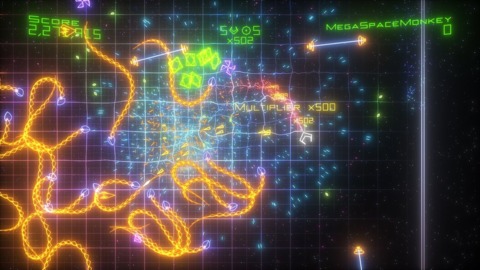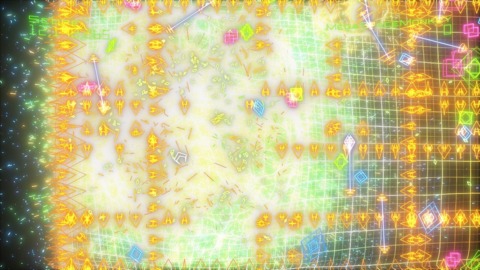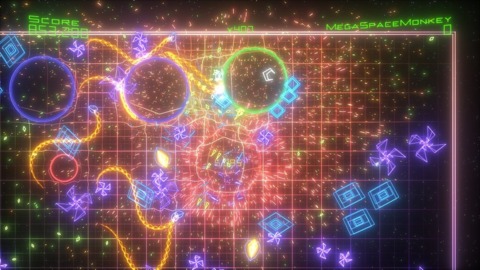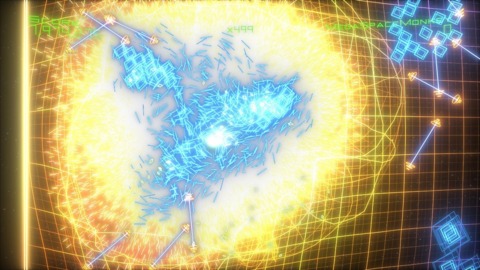Q&A: Bizarre surveys Geometry Wars 2 aftermath
Stephen Cakebread and Craig Howard talk about pulling inspiration for the XBLA shooter from Spyro the Dragon and Brain Age, why they left out online play, and much more.
The original Geometry Wars: Retro Evolved was one of the Xbox 360 launch's biggest success stories. Developed by Project Gotham Racing studio Bizarre Creations, the frantic shooter highlighted the benefits of integrated Xbox Live features such as leaderboards and achievements, and proved that downloadable console games could become breakout hits.
The $5 downloadable game spawned Geometry Wars: Galaxies, a full-price retail spin-off for Nintendo's Wii and DS; a bite-size Geometry Wars: Waves game in Project Gotham Racing 4; and as of last month, a proper Xbox Live Arcade sequel. Although Geometry Wars: Retro Evolved 2 doubled the original's asking price, it won critical acclaim, thanks to revamped gameplay and a diverse selection of new modes.

With a few weeks' worth of hindsight, Bizarre senior coder Stephen Cakebread and games manager Craig Howard answered some questions for GameSpot this week about the creation of their latest sequel, what they still aren't happy with, and what's next for the franchise.
GameSpot: To make a sequel, you probably had to first identify some deficiencies in the original Retro Evolved. What flaws did you come up with that were most in need of addressing in the follow-up?
Stephen Cakebread: There were a few things in GWRE that I wanted to fix for the sequel:
--To make the games much shorter, I didn't want the top spots of the leaderboards to be a test of endurance like they were in GWRE1. People were basically spending 20 hours-plus playing the game to post a score.
--To make sure the player had something to do other than flying in a circle all the time, which is where the idea for geoms and the gates came from (both of which tempt you out of the repetitive circle motions GWRE1 players used to fall into).
--To make dying feel like less of a penalty, so people would complete their games, rather than chain restarting until they got a good score on their first life.
Craig Howard: For me there were two main areas that could be improved. The scoring system in the original game gave you a multiplier for enemies killed and it was quite hardcore. The other area that needed to be improved was that it would take a long time for the more experienced players to get the game up to speed. We wanted to ensure that everyone would have an enjoyable experience from the beginning of their game.
GS: Geometry Wars: Galaxies made a number of significant changes to the Retro Evolved formula, some of which found their way into Retro Evolved 2, some of which did not. What was the rationale for the changes you kept (like geoms) and those you left behind (differently shaped levels)?
CH: We designed GW: Galaxies after we had already started Retro Evolved 2. We considered GW: Galaxies as a sidestep for the Geometry Wars franchise and wanted to explore different avenues of gameplay within the Geometry Wars universe.
SC: In fact, we were originally going to ship GWRE2 a few months before GW: Galaxies! However, as the release date for Galaxies drew closer, we decided that we weren't going to be able to finish GWRE2 with the level of polish we require in the time we had left, so we decided to postpone the game until after Galaxies had shipped. Geoms were actually the first new mechanic added to GWRE2, and they worked so well, we decided they should be in Galaxies as well. We did experiment with different arena shapes for GWRE2, but we found the challenge-style levels worked best in the square arena, and altering the size of the arena made a vast difference to the difficultly, so in the end we decided to keep the game consistent with the same arena in all levels. That said, the individual levels in sequence would have worked with different arena shapes, it was just something we never got around to implementing for that mode.
CH: Yep, we did know that geoms were already very strong in our version of GWRE2, so we wanted to take them across to GW: Galaxies. Some of the other ideas such as the drone and the different grid types were things that we want to explore further within the Galaxies series.

GS: Where did Geometry Wars: Waves fit into the big picture? Why was it never released on its own? Was it created for any reason other than maintaining the tradition of Geometry Wars in Project Gotham games?
CH: Waves was already up and running in our game, so we put it into Gotham as a teaser to see if people liked our "blip"-style game modes.
SC: We felt it had become a bit of a tradition, too! So that's why we wanted to ship a GW game as a PGR4 Easter egg. However, when the time came to put something into Gotham, the only part of the game we thought was polished enough to include was Waves. We never released it on its own, as it was always supposed to be part of GWRE2, but we also felt that it wasn't a large-enough game to qualify as a stand-alone release, given the games which were starting to appear on XBLA.
GS: In Retro Evolved, enemy movement was tied to the player's own movement (with the exception of black holes and pinwheels). Geometry Wars 2 features more enemies (and more common enemies) that don't move in relation to the player, like the arrow-shaped Waves enemies. Was that a conscious choice, and if so, why was it made?
CH: These new enemies can mix up how the player has to move around the arena. The rocket enemies stop the players camping on the screen and also stops them relying on the circular-shooting tactic that some used in the first Evolved.
SC: One issue with the original game was that players would lapse into doing laps around the arena; this meant that with all the enemies just following the player, they'd just end up in a large clump behind him. So to counteract this, in addition to adding geoms to tempt the player to double back on themselves, I made some of the enemies ignore the player completely in their movement patterns; this reduces the effectiveness of just flying in one direction all the time and makes the new enemies a little more predictable, as I didn't need to add odd movement patterns to make them feel different.
GS: What are the key things that separate a Geometry Wars game from just another twin-analog-stick-shooter, the elements you knew absolutely had to be in the game?
SC: I believe our take on the visual style, scoring-focused gameplay, and enemy-spawning chaos are the key things that make Geometry Wars feel different to the other twin-stick shooters out there.
CH: I really think the "less is more" approach is best when making these games. Our enemies are clearly defined and have a lot of personality, but it's the interaction between them and the other enemies that creates interesting emergent-gameplay dynamics that keep the game feeling fresh whenever you play it.

GS: How close is the finished game to what you originally had in mind?
SC: Our initial spec was to create something which had the same feeling to play as GWRE; we didn't want to change the mechanics too much, or make the game too large. This was partially because we didn't want to step on GW: Galaxies' toes, but also because we felt GWRE had its own identity and we wanted the sequel to build on that, not knock it down and start again. So the final game is very close to those goals, although in the process of getting there we experimented with many designs that were completely at odds with it! For example, we experimented with Ikaruga-style colour-switching at one point, which made for very intense games but was so insanely hard we had to drop it!
CH: Its quite different in some ways, there are a fair few game modes that didn't make it into the final game, but I think the overall goal of the project is quite close. We wanted to make a game that was more accessible and pure.
GS: What worked out best with Geometry Wars 2?
SC: I feel the geoms and multiple challenges were probably the best additions to GWRE2. The geoms make the moment-to-moment gameplay deeper, giving the player another mechanic to worry about without making the game overly complex; and the separate challenges have given the game more breadth to keep people engaged for longer by jumping between different modes during their play sessions, while still keeping the individual game lengths short so it can still be played in party/limited-time situations.
CH: The variety of play modes does it for me, as they all call on different skills from the player so you can chop and change between them depending on how you feel. It's rare when you work on a game for this long and still find yourself playing it daily!
GS: What didn't work out like you hoped, or could still be improved upon?
SC: There's lots of things in the game that still niggle at me, but at some point you just have to let go. Two that come to mind are the multiplayer camera and player respawning. Both were compromises that we never really found a good solution for.
CH: We also had some very innovative game modes that didn't quite work in this package, so they were dropped, but it would be good to revisit them in some way in the future.
GS: Did you pull any lessons on what to do (or what not to do) from the glut of other twin-stick shooters on the market?
SC: We experimented with a lot of different mechanics from a lot of different games, not just twin-stick shooters. For example, the unlock mechanic for the game modes was originally inspired by Brain Training on the DS. I really enjoyed the way it would reward you just for playing the game. I wanted that same feeling in GWRE2, as a lot of games feel like they're making you work to unlock the game rather than just have fun playing it.

GS: The achievements in Geometry Wars 2 stand out from those of most Xbox 360 games. They change the way you play the game (in a fun way), they have onscreen cues giving players progress reports, and they're mostly creative goals in the same category as Retro Evolved's Pacifism award. Why are achievements like this so rare? How early in development did you have these achievements planned out?
CH: These are usually made once we are happy with a game, we then look at how to challenge the way you play it to create interesting alternative goals. These really only come with many, many hours of playing the game!
SC: The achievements were actually the very last thing to go into the game, partially because, until we'd nailed it all down, we didn't know which modes were going to stay, and we didn't want to spend time designing achievements for modes or features that might be cut. That said, we had been collecting ideas together for the entire development cycle, so when we finally sat down to design them, it was fairly easy to cherry-pick the best ones from the pool we had.
My first experience of "achievements" were skill points in Insomniac's Spyro games. In those games, the skill points were generally about doing something you wouldn't normally do, which really added to the game's longevity, as they weren't something you'd pick up by accident without intentionally going back and trying to earn them. I wanted to get some of that same feeling with the achievements in GW, so when we were designing them, we focused on ideas that would make the player play differently, rather than just play more efficiently. That's not to say that achievements that just reward playing well aren't important; it's about getting the right mix between the two.
GS: Were any of the achievements intended to serve almost as tutorials for the modes, where forcing players to alter the way they played each mode would intentionally direct them to the "right" way of playing the mode to maximize success?
SC: I did consider that when designing a few achievements for GWRE1, but for GWRE2 we designed the different modes to be tutorials for each other, that is, some are designed to improve your moving skills, some to improve your aiming, and so on. So we felt the achievements didn't really need to have a strong tutorial nature about them, which lets us focus on making the achievements feel fun and different from one another. The problem with XBLA downloadable games is that we're only allowed to award 12 achievements, so we're quite restricted on what we can include.
GS: Why is there no online multiplayer in Geometry Wars: Retro Evolved 2?
SC: There are several ways we could have tackled online multiplayer in GW, and I'm by no means saying it's not possible to do; it's just that at the end of the day with the amount of data we would have had to send across the wire, we would need to have made some gameplay compromises to accommodate it. Lag would be completely unacceptable in a game like GW, so a server architecture would be right out. This means all clients would have to simulate the game themselves. That means the clients aren't going to be playing quite the same game (nearly the same game, but ultimately, not the same game), which means any fighting over who kills an enemy, who picks up a geom, who grabs the power-up, it's all gone, and that's what makes multiplayer Geometry Wars interesting. Remove it, and you might as well just be playing against a prerecorded ghost, given how much influence you'd have on what the other player was doing.
That said, could we have created a Geometry Wars-themed multiplayer component to the game if we weren't shackled by the current game rules? Absolutely, but that would have expanded the scope of the game way beyond our original design and would have taken much longer to develop.
GS: Why aren't there power-ups in the single-player game?
SC: Power-ups work best in games where each play session lasts a fair amount of time. You've then got enough time to experience the difference between having a power-up and not having it (several times over), which gives power-ups real weight in the game. In GWRE2, the game modes are all very short. There's not really enough time to appreciate the difference between having a power-up and not having one, and the difference between getting one and not getting one has a disproportionate effect on your score for that session. Given that Geometry Wars is already quite a random game due to the way enemies spawn, we decided we wanted to keep all the mechanics in the game as predictable as possible, which is why we cut power-ups from the single-player game. However, with multiplayer not being balanced in the same way, we did add them back there to keep players on their toes!
GS: What did you think of the critical reception to the game? Was anything praised or panned unexpectedly?
SC: We were hoping for a good reception, but you never know what will happen until the game is out there! It has exceeded our expectations, though; we were always concerned that people wouldn't appreciate what was new for the sequel. I don't think anything has been panned that we didn't expect to see complaints about, but at the end of the day, everything in the game is the way it is because we iterated and tried as many ideas as we could, and we always went with what we felt worked the best.
CH: Indeed, it's great when people understand the ambition behind a game, and more importantly enjoy playing it.
GS: Games from indie developers and small teams are increasingly carving out a niche for themselves, with titles like Everyday Shooter and Braid recently finding acclaim. You're obviously no longer an independent developer, but do you feel any kinship with the burgeoning indie scene? Do you think Retro Evolved helped open doors for projects like these to find wide exposure?
SC: If GWRE did anything, I think it was to show that people would be willing to buy a previously unknown game on XBLA so long as it was fun and well presented. I'm sure if GWRE hadn't been there at launch, we would have seen another game take that title. We just got lucky being there first!
CH: We are always fascinated by the ideas and the energy that the independent scene has, and we do play a wide range of homegrown titles.
GS: Where does the Geometry Wars franchise go from here?
SC: Well, I'm still holding out hope for a live-action movie...
CH: Shhhhh! You're not meant to mention that!
Got a news tip or want to contact us directly? Email news@gamespot.com
Join the conversation